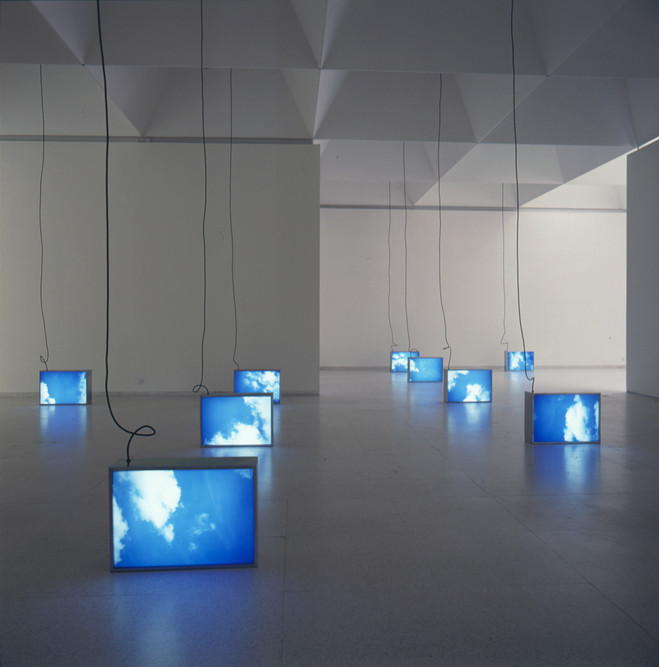IFP – PERROTIN
Galerie Perrotin, 76 rue de Turenne, 75003 Paris, Tel. +33 142167979
March 16 - May 13, 2017
www.perrotin.com
Information Fiction Publicité
/
Opening Reception: Thursday 16 March 4-9pm
/
Perrotin gallery is pleased to host an exhibition of the artistic collective
Information Fiction Publicité on the occasion of the publication
of their monograph by the Presses du Reel / Editions Perrotin.
Following their solo shows at the MAMCO in Genève (2010) and
at the MACVAL in Vitry sur Seine (2012), this exhibition will highligt
historical works.
/
Created in 1984 by Jean-François Brun, Dominique Pasqualini and
Philippe Thomas, IFP, the collective worked until 1994 (in 1985 Philippe
Thomas quit the collective, embarking on a career of his own).
Emmanuel Perrotin met Jean-François Brun and Dominique Pasqualini
at the end of the eighties. One of his first exhibition was dedicated to
IFP when his gallery was settled in his appartment, rue de Turbigo (1992).
Between agency, brand and artistic collective, IFP questions the
authorship of an artwork : Their works – in which clouds appear as a
recurring motif – are never signed and thus escape the tyranny of the
name. The collective exerted considerable influence, especially for their
thinking on and deconstruction of the concepts of representation,
exhibition, dissemination and the mediatisation of art.
/
“This is an embleme, but it’s also eventually a diagnostic of what
is art, our definition of art in general, namely art is about information,
fiction and publicity. And this applies both for a 14th century retable,
a Poussin and a Warhol”
/
Essentially preoccupied with the social space where public
advertising totally blurs into the private life of the individual, and,
perhaps more importantly, the (then) extremely fashionable issues
of authorship, the work consists largely of three parts: their logo
(featured on sculptures and light boxes); images of the sky; and
advertising in various forms.
Grande Surface (1987-2010), is a vast billboard-size, green
monochrome wall painting. At the bottom right corner of the painting
is located the collection’s logo in white, next to a fold out seat, as in
a movie theater, upon which a single viewer could sit and contemplate
the sprawling frieze of re-contextualized, public imagery before them,
while activating, for the benefit of other viewers, the field of green
directly behind them. Together, the two offered a rather wry commentary
on Duchamp’s famous observation that the viewer completes, who in
this case, is literally instrumentalized by the work in order to achieve
said completion.
Le plot (1985), seems, at least in theory, to invite a similarly instrumental engagement/exploitation. These are basically small, round concrete plinths,
whose center’s featured mechanically rotating, metal plates, upon which is
painted the collective’s logo.
Difficult not to imagine a single viewer obediently standing on one
and, no doubt, expressionlessly, rotating like a human sculpture.
The motif that dominates the exhibition – the sky – (the group’s signature
image) just happened to be the most winsome motif of the exhibition.
Parceled up into light boxes, on folding partitions, and in a film, the
presence of the sky suffuses the spaces with an extraordinary and
inhuman, as in emotionless calm.
Ciel, station (1988), an overhead series of ten light boxes with images of
cloud spattered skies, spaced apart at symmetrical intervals. Evocative of
either a train window or say, a film strip, the installation is cause,
despite its elegant beauty, for a highly unnatural feeling.
One had the sense that the sky, and any romantic significations normally
associated with it, had been deprived of any content whatsoever, rendered
completely vacant, like a screensaver.
But it wasn’t until seeing a vertical, human-sized light box of the sky,
and after seeing a few images of inhuman spaces such as a desertscape
and a moonscape pasted directly unto the wall, that a preoccupation
with a colonization of space begin to assert itself. Indeed, the light
boxes of the sky themselves testified to the commodification of the one
thing that would seem to put up an indomitable resistance to being
packaged and sold. And yet here it is, streamlined into luminous and
entrancing segments of its own representation. Whether or not such
a critique was initially part of their project is hard to say– they were
notoriously uncommitted to any critical position, aside from that of
abjuring traditional notions of authorship. That said, if time has potentially
made a subtle critique of commodification within the work more
apparent, then one other latent aspect becomes even more apparent
than that: the memento mori. For what do these pure, artificial
representations (preservations) point to other than the extinction of
that to which they refer? Granted, these were made at the end of the
Cold War, post Soylent Green (1973), and above all, post Blade Runner
(1982), but the specter of ecological catastrophe, now psychically,
culturally and historically pushing down on them, has become a
thoroughgoing box office hit, not to mention an imminent reality.
However, unlike their spectacular Hollywood counterparts, the sense
of doom they both compactly and vastly invoke is wrapped in a peaceful
and impenetrable silence.
/
Chris Sharp
Except form the text “Information Fiction Publicité. L’épreuve du jour”,
published in the online supplement of Kaléidoscope Magazine, February 2011
